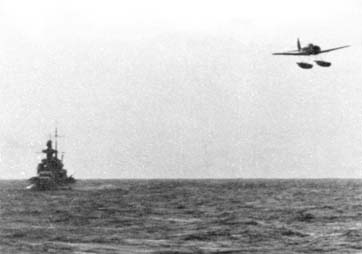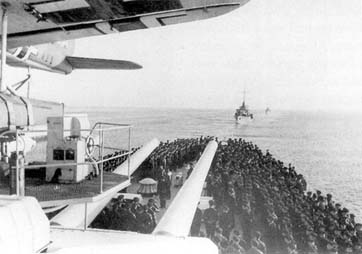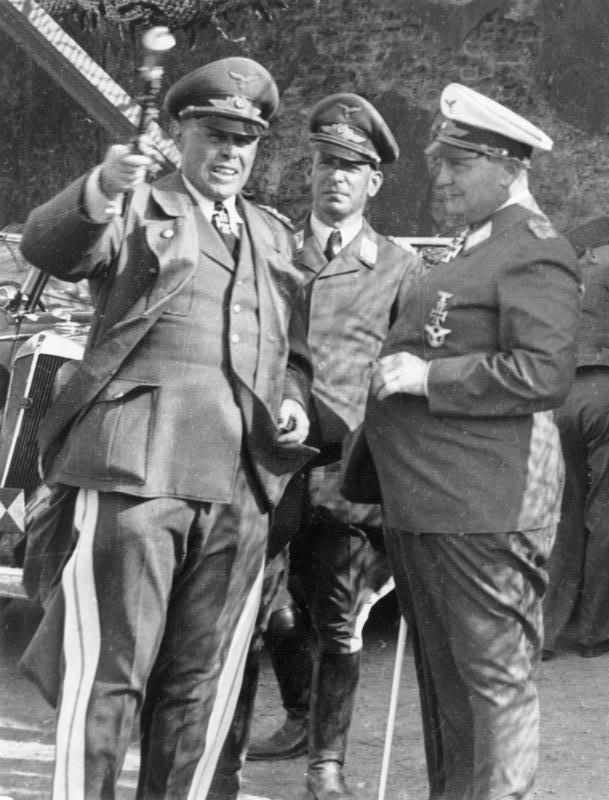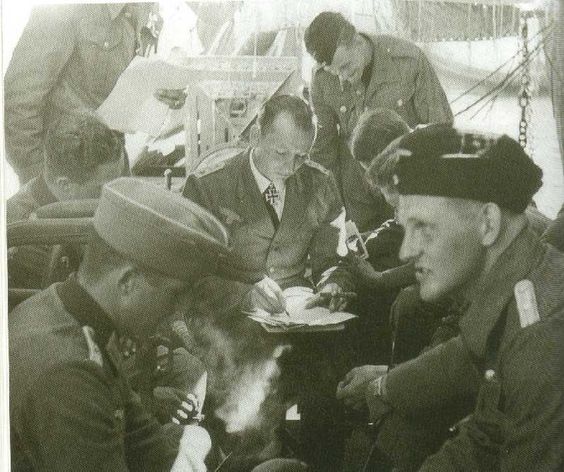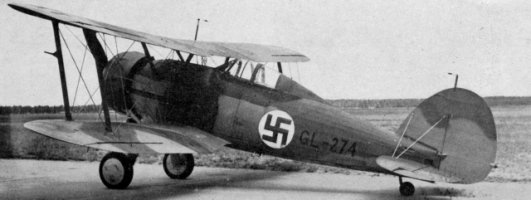Wednesday 24 April 1940
 |
| The German hierarchy in Norway: Vidkun Quisling, Heinrich Himmler, Reichskommissar Josef Terboven, and military commander Generaloberst Nikolaus von Falkenhorst in 1941 (Bundesarchiv, Bild 101III-Moebius-029-12 / Möbius / CC-BY-SA 3.0). |
Norway: The Germans, bypassing Quisling, on 24 April 1940 appoint Josef Antonius Heinrich Terboven as Reichskommissar or Gauleiter of Norway. Naturally, his authority ends at the range of German guns.
U.S. Naval Attaché Lt. Commander Ole E. Hagen, taking up where the deceased Robert E. Losey left off, escorts a party of American citizens evacuated from Oslo to the interior of Norway. Then, they cross into neutral Sweden and safety in Stockholm.
Norway Army Operations: German troops in eastern Norway advance past Lillehammer in the Osterdal and reach Rendal.
The British 15th Infantry Brigade (General Bernard Paget) lands at Andalsnes moves quickly to take up a blocking position at Kvam. The troops have been cooped up in the ships since the 15th.
The German 196th Infantry Division has crushed the British 148th Infantry Brigade, which, down to about 300 men, retires past the Paget's troops at Kvam to Otta. Otta is another key road junction in the chain of defiles that bisect Norway. The Germans are hot on the heels of the 148th Infantry Brigade and run into the fresh 15th Infantry Brigade.
At Hegra Fortress, the incessant German bombardment continues. Today, the Germans knock out the second and last of the 7.5 cm guns in the fortress, making it even less of a threat to the Germans. After this point, the Germans use an assortment of unusual or captured weaponry to gradually wear down this non-threatening nuisance.
At Narvik, the Norwegian 6th Brigade (General Carl Gustav Fleischer) attacks south towards Narvik at Gratangsbotn. The German mountain troops under General Dietl hold the attack at Lapphaug Pass. The crafty Germans circle back through an undefended pass near Gratangsbotn on Fjordbotneidet mountain and ambush the Norwegians, who have relaxed for the night. The Germans kill 34, wound 64, take 130 prisoners and set up a new position at Gratangsbotn, for casualties of their own of 9 dead and 16 wounded. The Germans at Narvik are elite troops, with high morale and well-led.
Norway Naval Operations: British battleship Warspite, which had been devastating during the Second Battle of Narvik, returns there with cruisers HMS Effingham, Enterprise and Aurora, and destroyer Zulu (they are screened by British destroyers HMS Encounter, Escort, Faulknor, Foxhound, Havock, Hero, Hostile and Polish destroyers Blyskawica and Grom). The battleship force, under the command of Admiral of the Fleet Lord Cork, once again boldly sails up the Ofotfjord and bombards Narvik again for three hours and point-blank range. HMS Effingham sinks captured British cargo ship Riverton at the dock.
However, the accompanying cruiser Vindictive, which is loaded with troops for a landing, does not land its troops after the commanding British army General cancels the landing. Here is where it gets controversial: despite the devastating firepower assembled, it is said that the flat trajectory of the ships' fire does not sufficiently eliminate the enemy according to the standard story.
Many thus later blame Cork for the failed invasion at Narvik, because he is an easy target who has been brought back off the retired list and has seniority over everybody else, so nobody dares to question him. However, the British are facing determined German troops who do not easily succumb. Both Cork - no pansy - and General Orrey in command of the ground troops actually go ashore, but they find that the snow makes the landing too difficult against mountain troops dug in all over the fjord. It is impossible to square the legend - that the fleet approached too close to town to destroy the defenders - with the reality that it was the ground commander who called off the invasion due to the weather conditions.
Three French destroyers in the Skagerrak battle German patrol boats and also fend off Luftwaffe attacks.
European Air Operations: The RAF raids five Luftwaffe airfields which are supporting German ground operations in Norway: Aalborg, Kristiansand, Oslo, Stavanger, and Westerland on the island of Sylt. During the raid, the RAF sinks two German patrol boats north of Sylt. Luftwaffe fighters challenge the British bombers over Stavanger.
The RAF conducts armed reconnaissance over Trondheim Fjord.
HMS Glorious sends its cargo of 18 No. 263 Squadron Gloster Gladiators to frozen Lake Lesjaskogsvatnet, between Andalsnes and Dombås. The operation once again shows poor planning, as the lake base has no anti-aircraft support.
The Luftwaffe bombs Åndalsnes during the day. They badly damage the British anti-aircraft cruiser HMS Curacoa with a bomb that crashes through the deck in front of the bridge, explodes, and kills 45 men and wounds 36. The ship has to withdraw to Chatham.
Royal Navy aircraft carrier Ark Royal sends its Fleet Air Arm aircraft into battle against German fighters over Trondheim.
The Luftwaffe bombs Scapa Flow during the night. After dropping some bombs on land and machine-gunning a road, the RAF and anti-aircraft drive them off.
Battle of the Atlantic: U-23 spots British cruiser HMS York while it is steaming back to Scapa Flow after having deposited Paget's troops at Åndalsnes. Despite two attempts, the U-boat fails to hit the fast cruiser.
British freighters Stokesley and Rydal Forces hit mines in the English Channel and sink.
Convoy OA 135G departs from Southend, Convoy OB 134 departs from Liverpool, and Convoy OB 135 departs from Liverpool.
German armed auxiliary cruiser Orion sinks British freighter Haxby east of Bermuda.
Spy Stuff: Two British destroyers, HMS Griffin and Acheron, are on patrol in the North Sea when they stop a freighter for inspection off Andalsnes, about halfway between Bergen and Trondheim on the Norwegian coastline. The ship's captain claims that it is an ordinary Dutch trawler. The British boarding party from Griffin does a thorough inspection and finds that it is the disguised Kriegsmarine surface raider Schiff 26 - the Polares. It is trying to bring supplies to Narvik.
The German crew acts quickly and throws a weighted bag overboard. The British act even quicker and retrieve the bag before it sinks. It turns out to contain some of the German Enigma machine coding machine keys for the period 23–26 April, including the procedures for scrambling the rotors.
These are quickly sent to Bletchley Park, site of the Ultra decoding project. The cryptanalysts there use the information to program their "Bombe" electro-mechanical computers. The machines prove that they can decode German transmissions from this time period.
This is a clear breakthrough for the Ultra team. Now, they have proven that their system works. From this point on, the Royal Navy is tasked with finding new "cribs" such as the ones from the Polares to enhance their code-breaking. Ultimately, this enables the Bombes to break German codes even without recent cribs.
China: At Macao, the Japanese advance and force the police to retreat into the Portuguese colony.
American Homefront: Baseball legend Lou Gehrig makes what is believed to be his final dugout appearance during a Yankees game.
April 2, 1940: British Subs On Alert
April 3, 1940: Churchill Consolidates Power
April 4, 1940: Missed the Bus
April 5, 1940: Mig-1 First Flight
April 6, 1940: Troops Sailing to Norway
April 7, 1940: Fleets At Sea
April 8, 1940: HMS Glowworm and Admiral Hipper
April 9, 1940: Invasion of Norway
April 10, 1940: First Battle of Narvik
April 11, 1940: Britain Takes the Faroes
April 12, 1940: Germans Consolidate in Norway
April 13, 1940: 2d Battle of Narvik
April 14, 1940: Battle of Dombås
April 15, 1940: British in Norway
April 16, 1940: Germans Cut Norway in Half
April 17, 1940: Trondheim the Target
April 18, 1940: Norway Declares War
April 19, 1940: Dombås Battle Ends
April 20, 1940: Germans Advancing in Norway
April 21, 1940: First US Military Casualty
April 22, 1940: First British Military Contact with Germans
April 23, 1940: British Retreating in Norway
April 24, 1940: British Bombard Narvik
April 25, 1940: Norwegian Air Battles
April 26, 1940: Norwegian Gold
April 27, 1940: Allies to Evacuate Norway
April 28, 1940: Prepared Piano
April 29, 1940: British at Bodo
April 30, 1940: Clacton-on-Sea Heinkel
2019
U.S. Naval Attaché Lt. Commander Ole E. Hagen, taking up where the deceased Robert E. Losey left off, escorts a party of American citizens evacuated from Oslo to the interior of Norway. Then, they cross into neutral Sweden and safety in Stockholm.
Norway Army Operations: German troops in eastern Norway advance past Lillehammer in the Osterdal and reach Rendal.
The British 15th Infantry Brigade (General Bernard Paget) lands at Andalsnes moves quickly to take up a blocking position at Kvam. The troops have been cooped up in the ships since the 15th.
The German 196th Infantry Division has crushed the British 148th Infantry Brigade, which, down to about 300 men, retires past the Paget's troops at Kvam to Otta. Otta is another key road junction in the chain of defiles that bisect Norway. The Germans are hot on the heels of the 148th Infantry Brigade and run into the fresh 15th Infantry Brigade.
At Hegra Fortress, the incessant German bombardment continues. Today, the Germans knock out the second and last of the 7.5 cm guns in the fortress, making it even less of a threat to the Germans. After this point, the Germans use an assortment of unusual or captured weaponry to gradually wear down this non-threatening nuisance.
At Narvik, the Norwegian 6th Brigade (General Carl Gustav Fleischer) attacks south towards Narvik at Gratangsbotn. The German mountain troops under General Dietl hold the attack at Lapphaug Pass. The crafty Germans circle back through an undefended pass near Gratangsbotn on Fjordbotneidet mountain and ambush the Norwegians, who have relaxed for the night. The Germans kill 34, wound 64, take 130 prisoners and set up a new position at Gratangsbotn, for casualties of their own of 9 dead and 16 wounded. The Germans at Narvik are elite troops, with high morale and well-led.
Norway Naval Operations: British battleship Warspite, which had been devastating during the Second Battle of Narvik, returns there with cruisers HMS Effingham, Enterprise and Aurora, and destroyer Zulu (they are screened by British destroyers HMS Encounter, Escort, Faulknor, Foxhound, Havock, Hero, Hostile and Polish destroyers Blyskawica and Grom). The battleship force, under the command of Admiral of the Fleet Lord Cork, once again boldly sails up the Ofotfjord and bombards Narvik again for three hours and point-blank range. HMS Effingham sinks captured British cargo ship Riverton at the dock.
However, the accompanying cruiser Vindictive, which is loaded with troops for a landing, does not land its troops after the commanding British army General cancels the landing. Here is where it gets controversial: despite the devastating firepower assembled, it is said that the flat trajectory of the ships' fire does not sufficiently eliminate the enemy according to the standard story.
Many thus later blame Cork for the failed invasion at Narvik, because he is an easy target who has been brought back off the retired list and has seniority over everybody else, so nobody dares to question him. However, the British are facing determined German troops who do not easily succumb. Both Cork - no pansy - and General Orrey in command of the ground troops actually go ashore, but they find that the snow makes the landing too difficult against mountain troops dug in all over the fjord. It is impossible to square the legend - that the fleet approached too close to town to destroy the defenders - with the reality that it was the ground commander who called off the invasion due to the weather conditions.
Three French destroyers in the Skagerrak battle German patrol boats and also fend off Luftwaffe attacks.
 |
| Narvik and surrounding hills aflame after the 24 April 1940 shelling. |
The RAF conducts armed reconnaissance over Trondheim Fjord.
HMS Glorious sends its cargo of 18 No. 263 Squadron Gloster Gladiators to frozen Lake Lesjaskogsvatnet, between Andalsnes and Dombås. The operation once again shows poor planning, as the lake base has no anti-aircraft support.
The Luftwaffe bombs Åndalsnes during the day. They badly damage the British anti-aircraft cruiser HMS Curacoa with a bomb that crashes through the deck in front of the bridge, explodes, and kills 45 men and wounds 36. The ship has to withdraw to Chatham.
Royal Navy aircraft carrier Ark Royal sends its Fleet Air Arm aircraft into battle against German fighters over Trondheim.
The Luftwaffe bombs Scapa Flow during the night. After dropping some bombs on land and machine-gunning a road, the RAF and anti-aircraft drive them off.
Battle of the Atlantic: U-23 spots British cruiser HMS York while it is steaming back to Scapa Flow after having deposited Paget's troops at Åndalsnes. Despite two attempts, the U-boat fails to hit the fast cruiser.
British freighters Stokesley and Rydal Forces hit mines in the English Channel and sink.
Convoy OA 135G departs from Southend, Convoy OB 134 departs from Liverpool, and Convoy OB 135 departs from Liverpool.
German armed auxiliary cruiser Orion sinks British freighter Haxby east of Bermuda.
 |
| HMS Griffin (H31). |
The German crew acts quickly and throws a weighted bag overboard. The British act even quicker and retrieve the bag before it sinks. It turns out to contain some of the German Enigma machine coding machine keys for the period 23–26 April, including the procedures for scrambling the rotors.
These are quickly sent to Bletchley Park, site of the Ultra decoding project. The cryptanalysts there use the information to program their "Bombe" electro-mechanical computers. The machines prove that they can decode German transmissions from this time period.
This is a clear breakthrough for the Ultra team. Now, they have proven that their system works. From this point on, the Royal Navy is tasked with finding new "cribs" such as the ones from the Polares to enhance their code-breaking. Ultimately, this enables the Bombes to break German codes even without recent cribs.
China: At Macao, the Japanese advance and force the police to retreat into the Portuguese colony.
American Homefront: Baseball legend Lou Gehrig makes what is believed to be his final dugout appearance during a Yankees game.
 |
| A huge fire in Natchez claims a hundred or more lives. |
April 1940
April 1, 1940: Weserubung is a GoApril 2, 1940: British Subs On Alert
April 3, 1940: Churchill Consolidates Power
April 4, 1940: Missed the Bus
April 5, 1940: Mig-1 First Flight
April 6, 1940: Troops Sailing to Norway
April 7, 1940: Fleets At Sea
April 8, 1940: HMS Glowworm and Admiral Hipper
April 9, 1940: Invasion of Norway
April 10, 1940: First Battle of Narvik
April 11, 1940: Britain Takes the Faroes
April 12, 1940: Germans Consolidate in Norway
April 13, 1940: 2d Battle of Narvik
April 14, 1940: Battle of Dombås
April 15, 1940: British in Norway
April 16, 1940: Germans Cut Norway in Half
April 17, 1940: Trondheim the Target
April 18, 1940: Norway Declares War
April 19, 1940: Dombås Battle Ends
April 20, 1940: Germans Advancing in Norway
April 21, 1940: First US Military Casualty
April 22, 1940: First British Military Contact with Germans
April 23, 1940: British Retreating in Norway
April 24, 1940: British Bombard Narvik
April 25, 1940: Norwegian Air Battles
April 26, 1940: Norwegian Gold
April 27, 1940: Allies to Evacuate Norway
April 28, 1940: Prepared Piano
April 29, 1940: British at Bodo
April 30, 1940: Clacton-on-Sea Heinkel
2019




